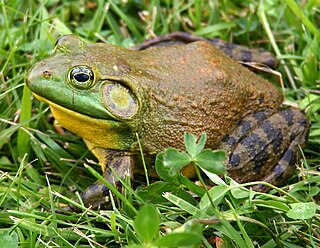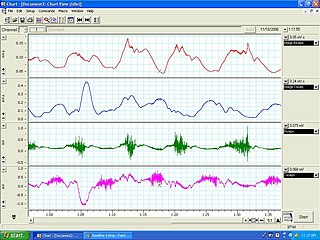Related Research Articles

Chameleons or chamaeleons are a distinctive and highly specialized clade of Old World lizards with 200 species described as of June 2015. The members of this family are best known for their distinct range of colors, being capable of shifting to different hues and degrees of brightness. The large number of species in the family exhibit considerable variability in their capacity to change color. For some, it is more of a shift of brightness ; for others, a plethora of color-combinations can be seen.

The American bullfrog, often simply known as the bullfrog in Canada and the United States, is a large true frog native to eastern North America. It typically inhabits large permanent water bodies such as swamps, ponds, and lakes. Bullfrogs can also be found in manmade habitats such as pools, koi ponds, canals, ditches and culverts. The bullfrog gets its name from the sound the male makes during the breeding season, which sounds similar to a bull bellowing. The bullfrog is large and is commonly eaten throughout its range, especially in the southern United States where they are plentiful.

Skeletal muscles are organs of the vertebrate muscular system and typically are attached by tendons to bones of a skeleton. The muscle cells of skeletal muscles are much longer than in the other types of muscle tissue, and are often known as muscle fibers. The muscle tissue of a skeletal muscle is striated – having a striped appearance due to the arrangement of the sarcomeres.

Muscle contraction is the activation of tension-generating sites within muscle cells. In physiology, muscle contraction does not necessarily mean muscle shortening because muscle tension can be produced without changes in muscle length, such as when holding something heavy in the same position. The termination of muscle contraction is followed by muscle relaxation, which is a return of the muscle fibers to their low tension-generating state.

A muscular hydrostat is a biological structure found in animals. It is used to manipulate items or to move its host about and consists mainly of muscles with no skeletal support. It performs its hydraulic movement without fluid in a separate compartment, as in a hydrostatic skeleton.
Reciprocal inhibition describes the relaxation of muscles on one side of a joint to accommodate contraction on the other side. In some allied health disciplines, this is known as reflexive antagonism. The central nervous system sends a message to the agonist muscle to contract. The tension in the antagonist muscle is activated by impulses from motor neurons, causing it to relax.

The Q10 temperature coefficient is a measure of temperature sensitivity based on the chemical reactions.

In pathology, a contracture is a shortening of muscles, tendons, skin, and nearby soft tissues that causes the joints to shorten and become very stiff, preventing normal movement. A contracture is usually permanent, but less commonly can be temporary, or resolve over time but reoccur later in life.

Odontomachus bauri is a species of ponerinae ant known as trap jaw ants. The trap jaw consists of mandibles which contain a spring-loaded catch mechanism.

Muscle coactivation occurs when agonist and antagonist muscles surrounding a joint contract simultaneously to provide joint stability, and is suggested to depend crucially on supraspinal processes involved in the control of movement. It is also known as muscle cocontraction, since two muscle groups are contracting at the same time. It is able to be measured using electromyography (EMG) from the contractions that occur. The general mechanism of it is still widely unknown. It is believed to be important in joint stabilization, as well as general motor control.

Ambush predators or sit-and-wait predators are carnivorous animals that capture or trap prey via stealth, luring or by strategies utilizing an element of surprise. Unlike pursuit predators, who chase to capture prey using sheer speed or endurance, ambush predators avoid fatigue by staying in concealment, waiting patiently for the prey to get near, before launching a sudden overwhelming attack that quickly incapacitates and captures the prey.

The three-lined salamander is a species of salamander in the family Plethodontidae. It is endemic to the south-eastern United States. Like other Plethodontidae species, E. guttolineata captures prey via tongue projection.
Myomeres are blocks of skeletal muscle tissue arranged in sequence, commonly found in aquatic chordates. Myomeres are separated from adjacent myomeres by connective fascia (myosepta) and most easily seen in larval fishes or in the olm. Myomere counts are sometimes used for identifying specimens, since their number corresponds to the number of vertebrae in the adults. Location varies, with some species containing these only near the tails, while some have them located near the scapular or pelvic girdles. Depending on the species, myomeres could be arranged in an epaxial or hypaxial manner. Hypaxial refers to ventral muscles and related structures while epaxial refers to more dorsal muscles. The horizontal septum divides these two regions in vertebrates from cyclostomes to gnathostomes. In terrestrial chordates, the myomeres become fused as well as indistinct, due to the disappearance of myosepta.

Undulatory locomotion is the type of motion characterized by wave-like movement patterns that act to propel an animal forward. Examples of this type of gait include crawling in snakes, or swimming in the lamprey. Although this is typically the type of gait utilized by limbless animals, some creatures with limbs, such as the salamander, forgo use of their legs in certain environments and exhibit undulatory locomotion. In robotics this movement strategy is studied in order to create novel robotic devices capable of traversing a variety of environments.
Role of skin in locomotion describes how the integumentary system is involved in locomotion. Typically the integumentary system can be thought of as skin, however the integumentary system also includes the segmented exoskeleton in arthropods and feathers of birds. The primary role of the integumentary system is to provide protection for the body. However, the structure of the skin has evolved to aid animals in their different modes of locomotion. Soft bodied animals such as starfish rely on the arrangement of the fibers in their tube feet for movement. Eels, snakes, and fish use their skin like an external tendon to generate the propulsive forces need for undulatory locomotion. Vertebrates that fly, glide, and parachute also have a characteristic fiber arrangements of their flight membranes that allows for the skin to maintain its structural integrity during the stress and strain experienced during flight.

Although projectiles are commonly used in human conflict, projectile use by organisms other than humans is relatively rare.
Normal aging movement control in humans is about the changes in the muscles, motor neurons, nerves, sensory functions, gait, fatigue, visual and manual responses, in men and women as they get older but who do not have neurological, muscular or neuromuscular disorder. With aging, neuromuscular movements are impaired, though with training or practice, some aspects may be prevented.
Elastic mechanisms in animals are very important in the movement of vertebrate animals. The muscles that control vertebrate locomotion are affiliated with tissues that are springy, such as tendons, which lie within the muscles and connective tissue. A spring can be a mechanism for different actions involved in hopping, running, walking, and serve in other diverse functions such as metabolic energy conservation, attenuation of muscle power production, and amplification of muscle power production.

A spinal interneuron, found in the spinal cord, relays signals between (afferent) sensory neurons, and (efferent) motor neurons. Different classes of spinal interneurons are involved in the process of sensory-motor integration. Most interneurons are found in the grey column, a region of grey matter in the spinal cord.

Anatomical terminology is used to uniquely describe aspects of skeletal muscle, cardiac muscle, and smooth muscle such as their actions, structure, size, and location.
References
- ↑ Lee, J.B., Matsumoto, T., Othman, T., Yamauchi, M., Taimura, A., Kaneda, E., Ohwatari, N. and Kosaka, M. (1999) Coactivation of the flexor muscles as a synergist with the extensors during ballistic finger extension movement in trained kendo and karate athletes. International Journal of Sports Medecine. 20(1): 7-11.
- 1 2 Zehr, E.P. and Sale, D.G. (1994). Ballistic movement: Muscle activation and neuromuscular adaptation. Canadian Journal of Applied Physiology. 19(4): 363-378.
- ↑ Lappin, A. K., Monroy, J. A., Pilarski, J. Q., Zepnewski, E. D., Pierotti, D. J. and Nishikawa, K. C. (2006). Storage and recovery of elastic potential energy powers ballistic prey capture in toads. Journal of Experimental Biology. 209: 2535-2553.
- ↑ Roberts, T. J. and Azizi, E. (2011) Flexible mechanisms: the diverse roles of biological springs in vertebrate movement. Journal of Experimental Biology. 214: 353-361.
- ↑ Deban, S. M., O’Reilly, J. C., Dicke, U. and van Leeuwen, J. L. (2007). Extremely high-power tongue projection in plethodontid salamanders. Journal of Experimental Biology. 210: 655-667.
- ↑ Deban, S.M. and Lappin, A.K. (2011). Thermal effects on the dynamics and motor control of ballistic prey capture in toads: maintaining high performance at low temperature. Journal of Experimental Biology. 214: 1333-134.
- ↑ Anderson, C. V. and Deban, S. M. (2010). Ballistic tongue projection in chameleons maintains high performance at low temperature. Proceedings of the National Academy of Sciences of the USA. 107:5495-5499.
- ↑ Patek, N., Baio, J. E., Fisher, B. L., & Suarez, A. V. (2006). Multifunctionality and mechanical origins: Ballistic jaw propulsion in trap-jaw ants. PNAS, 103: 12787-12792.
- ↑ Hustert, R., & Baldus, M. (2010). Ballistic Movements of Jumping legs implemented as variable components of cricket behavior. Journal of Experimental Biology, 213: 4055-4064
- ↑ Schulz, J. R., Norton, A. G., & Gilly, W. F. (2004). The Projectile Tooth of a Fish-Hunting Cone Snail: Conus catus inject Venom Into Fish Prey Using a High-Speed Ballistic Mechanism. Biol. Bull, 207: 77-79.
- ↑ Van Leeuwen, Johan L. (1997) Why the Chameleon Has Spiral-Shaped Muscle Fibres in its Tongue. Philosophical Transactions: Biological Sciences 352:1353 pp 573-589.
- ↑ Deban, S.M and Dicke U. (2004). Activation Patterns of the Tongue-Projector Muscle During Feeding in Imperial Cave Salamander Hydromantes imperialis. Journal of Experimental Biology 207 pp 2071-2081.
- ↑ Van Leeuwen J.L, De Groot J.H, Kier W.M (2000). Evolutionary Mechanics of Protrusible Tentacles an Tongues. Netherlands Journal of Zoology 50(2): 113-139.
- ↑ Vitaladevuni, S.N.P. (2007). Human Movement Analysis: Ballistic Dynamics, and Edge Continuity for Pose Estimation (PhD). University of Maryland.
- ↑ Accornero, N., Berardelli, A., Argenta, M. and Manfredi M. (1984). Two joints ballistic arm movements. Neuroscience Letters. 46: 91-95.